
Where Would You Expect Severe Weather?
YOU ARE A METEOROLOGIST at the National Weather Service and are responsible for providing an overview of weather conditions across the U.S. To do this, you will study maps showing weather conditions at the surface and aloft and then determine where and how different air masses are interacting. In addition, you will identify areas where […]
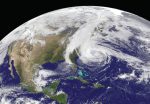
What Happened During Hurricane Sandy?
SEVERE STORMS are extremely dangerous, capable of killing thousands of people and inflicting incomprehensible damage. Severe weather — and the more benign varieties — develop, operate, move, and dissipate according to fundamental principles presented in this chapter. Here, we examine Hurricane Sandy, which in 2012 tracked up the East Coast of the U.S., before coming […]
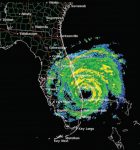
How Are We Warned About Severe Weather?
IN 1988, THE U.S. NATIONAL WEATHER SERVICE (NWS) began an aggressive program to modernize its capabilities in severe weather detection, forecasting, and communication, in support of its mission to protect life and property. As this program was implemented, weather forecasts have shown amazing improvement, particularly in severe weather advisories. The centerpiece of this modernization was […]

How Are Weather Forecasts Made?
THREE INGREDIENTS ARE NECESSARY for weather — energy, motion (both horizontal and vertical), and atmospheric moisture. The physical processes, such as energy transformations during phase changes of water (between solid, liquid, and gaseous states) are well understood, but several problems limit accurate weather forecasting. First, the equations describing the various transformations across three-dimensional space are […]

What Affects the Strength of a Tropical Cyclone?
AS A TROPICAL CYCLONE MOVES, it responds quickly to changes in the environment it encounters. In some cases, environ mental changes will cause a tropical cyclone to strengthen, perhaps becoming a hurricane or becoming a stronger hurricane. In other cases, the new environmental conditions cause a cyclone to weaken, dissipate, and eventually disappear. Considering the […]

What Is a Tropical Cyclone?
HURRICANES AND OTHER TROPICAL CYCLONES are some of nature's most impressive spectacles. These immense seasonal storms form over warm, tropical waters and can cause extremely heavy precipitation, all the while deriving energy from latent heat released by condensation and deposition. In the Atlantic and eastern Pacific, the most intense type of tropical cyclone is called […]

What Are Some Other Types of Wind Storms?
SEVERE WEATHER INCLUDES VARIOUS WIND STORMS in addition to tornadoes and cyclones. Some of these other storms — with interesting names like waterspouts, microbursts, haboobs, and derechos — can be extremely dangerous. What are their characteristics, how do they form, and where do they occur? Waterspouts A waterspout is a rotating, columnar vortex of air […]

Where and When Do Tornadoes Strike?
THE INTERIOR OF NORTH AMERICA has by far the most frequent tornado activity in the world. Tornadoes also occur, but far less frequently, in Europe, in the southeastern parts of South America and South Africa, and in a few other regions. Large parts of some continents, like all of North Africa and northern Asia, do […]

What Causes Lightning and Thunder?
LIGHTNING IS A DANGEROUS but intriguing weather phenomenon. It results from electrical currents within a storm cloud, releasing tremendous amounts of energy that can strike the ground. In the U.S., more than 80 deaths per year are due to lightning. Although this number is much less than those killed simply by extreme heat and extreme […]
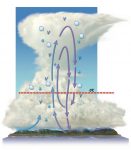
What Causes Hail?
HAIL IS A BALL OF ICE that forms under freezing temperatures within a cumulonimbus cloud and that subsequently falls toward the surface. Large hail that reaches the surface can do so at high enough speeds and with enough force to smash windows, dent cars, and destroy entire fields of crops. How does hail form, what […]
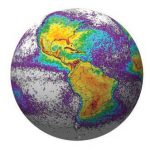
Where Are Thunderstorms Most Common?
THUNDERSTORMS CAN OCCUR as isolated single-cell thunderstorms, forming over mountains and other local features, or can be embedded in larger weather systems, like mid-latitude cyclones or multi-cell thunderstorms. By knowing how thunderstorms form, can you predict where they should be most common? How Does Thunderstorm Frequency Vary Globally? Space-based detections of lightning can be used […]

What Conditions Produce Thunderstorms?
THUNDERSTORMS ARE COLUMNS of moist, turbulent air with variable amounts of rain, strong wind, lightning, and hail. They are perhaps the most fundamental of all organized weather systems. They can provide needed rainfall for crops, but they can be accompanied by severe weather. We begin by examining the formation, growth, and decay of an individual […]

How Do Migrating Anticyclones Form and Affect North America?
ANTICYCLONES ARE ROTATING ZONES of high pressure. Most migrate across Earth's surface, guided by large-scale atmospheric circulation, but some stay or reappear in the same general area year after year. As migrating anticyclones approach, pass over, or leave an area, they cause changes in wind direction, temperature, and moisture. They are typically associated with non-stormy […]
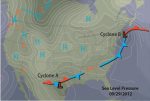
How Do Mid-Latitude Cyclones Move and Evolve?
ONCE FORMED, MID-LATITUDE CYCLONES migrate across the surface and commonly evolve through a series of steps, due to the way that winds circulate around the area of low pressure. Circulation around the cyclone will steer the trailing fronts in a counterclockwise direction (in the Northern Hemisphere), while west-to-east motion of the westerlies and Rossby waves […]

Where Do Mid-Latitude Cyclones Form and Cross North America?
WEATHER FRONTS generally do not exist in isolation, but typically form, migrate, and fade away as part of a larger system called a mid-latitude cyclone. Cold and warm fronts usually trail from a central core of low pressure — a cyclone. While popular culture uses the term “cyclone” to refer to a tornado or other […]
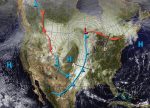
What Are Fronts?
THE NARROW ZONE separating two different air masses is called a front and is often the site of rising atmospheric motion. Whenever different air masses meet along a front, the less dense, warmer one will be pushed up over the more dense, colder one. If the rising air cools to its dew-point temperature, cloud formation […]
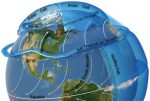
Why Does Weather Change?
THE ATMOSPHERE IS SO THIN that a single regional mass of cold or warm air can dominate the entire vertical extent of the troposphere. With time, such cold or warm air masses can expand or shrink, become colder or warmer, and can remain stationary or move great distances. In the narrow zone where the two […]
What Is Weather?
When we use the term weather, we are referring to conditions in the atmosphere at some specific time and place, whether it is right now, an hour ago, or sometime next week. Weather refers to the temperature, humidity, and windiness, and if it is fair or there is precipitation. It also refers to whether an […]

What Do Clouds Tell Us About Weather?
CLOUDS ARE ACCUMULATIONS of liquid water and ice suspended in the air. The types and amounts of clouds vary from place to place, from time to time, and from season to season. What are the different types of clouds, and how does each type form? Clouds provide clues not only about the amount and distribution […]

Gas giants and icy moons
Despite their frigidity, the four planets past Mars (Jupiter, Saturn, Neptune,and Uranus) manage to produce some interesting weather. One of their moons even has an atmosphere surprisingly similar to Earth's. All four planets have been dubbed gas giants, because the bulk of their interiors are made up of gases rather than solids (though Neptune and […]
Inside the inner planets
The first rule of planetary weather is an obvious one – planets are generally cooler the farther they are from the Sun. But temperature also depends strongly on the thickness of each planet's atmosphere. When that insulating blanket is thinner than ours, temperatures can vary greatly between daylight and darkness. Mercury offers the most vivid […]
Weather: Antarctica/Arctic
The unrelenting cold of the glacial continent of Antarctica boggles the mind. Much of the ice-covered Arctic Ocean melts or breaks up each summer. By contrast, all but roughly two percent of the Antarctic landmass is sealed year-round beneath a mass of ice up to 4.8km/3 miles deep. There's so much ice that, were it […]
Weather: South Pacific, Papeete, Suva
Richard Rodgers and Oscar Hammerstein picked the right venue for a lush, warm musical when they composed South Pacific. This enormous expanse of island-dotted ocean simply screams “tropics” – or perhaps it gently whispers that refrain. The only real weather worry in these parts are tropical cyclones (hurricanes). In general, they're most likely to threaten […]
Weather: New Zealand
Auckland | Christchurch | Wellington The weather across the two islands of New Zealand isn't especially violent or dramatic, but it does keep you guessing. The band of westerly winds across the South Island is known as the Roaring Forties, and with good reason. Across the planet, there's no other land at this latitude except […]
Weather: Australia
Alice Springs, Brisbane, Cairns, Darwin, Melbourne, Perth, Sydney You can't look at a map of Australian rainfall and temperature without being struck by the effect of the Great Dividing Range. This low-slung set of peaks shelters the population belt of Australia's southeast coast from the dry, blastfurnace heat found through the vast interior. The Outback's […]
Weather: Australasia/South Pacific
Water – or the lack of it – has everything to do with the weather across this vast realm where the Pacific and Indian Oceans meet. The island continent of Australia and its much smaller neighbours are surrounded by mammoth stretches of sea. If you took a globe and shifted it so New Zealand were […]
Weather: Vietnam, Cambodia, Laos
Although all of Vietnam sits within the tropics, there are dramatic weather variations between the north and south ends of this ribbon-like nation. Warmth is more or less guaranteed year-round across the southernmost delta surrounding Ho Chi Minh city, while northern Laos and Vietnam – adjacent to southeast China – can get surprisingly chilly in […]
Weather: Uzbekistan, Turkmenistan
Dust may be the most vivid weather feature across most of Uzbekistan and its southern neighbour, Turkmenistan. Each spring, great clouds of dust whipped up from the Kara Kum desert cascade across the land. They often follow in the wake of blustery thunderstorms that drop little if any rain. The dustiest regions are in central […]
Weather: Thailand, Myanmar
Cradled by mountains to its east and west, Thailand manages to avoid the worst extremes a monsoon climate can dish out. Although it's decidedly moist here, sunshine is widespread, especially in winter, which is almost rain-free across the country. Even during summer, a given day has roughly even odds of staying dry, outside of the […]
Weather: Tajikistan, Kyrgyzstan
Almost half of Tajikistan sits more than 3000m/9900ft above sea level. What's distinctive about the desolate highlands of Tajikistan and Kyrgyzstan is how dry they are. Pinched off from the Indian monsoon by the Himalayas and Tibetan plateau, these peaks get most of their winter snow as weak systems arrive from the west. Across the […]
Weather: Russia (including European Russia), Armenia, Azerbaijan, Georgia
Although its reputation precedes it, Russia's climate is extreme only after a particular fashion. There's no sugar-coating the fact that Russian winters are extremely cold. Yet much of the country enjoys warm mid-summer days that average above 20°C/68°F, and there are even a few bona fide hot spells. Thunderstorms are seldom intense outside of the […]
How winter came to Russia’s aid
Like a judo expert manipulating another's strength to his advantage, Russia learned through years of experience how to use the power of wintertime in its own defence. Would-be conquerors who extended their stay past the autumn equinox did so at their own risk, as Napoleon discovered in 1812. That September, some 400,000 of his troops […]
Weather: Philippines
Even the warm South China and Philippines Sea aren't quite enough to keep this chain of tropical islands from the effects of the Asian monsoon. While Mindanao and the southern Philippines stay warm to hot year round, Luzon (including Manila) experiences a few degrees of cooling, especially in the evening, from November to March. Winter […]
Weather: Nepal, Bhutan
The serene, snow-capped peaks of the Himalayas do more than loom over the Indian plains. During the summer, they stand firm against the southwest monsoon winds, forcing them to dump prodigious amounts of water across Nepal. The main climate differences through this zone hinge on elevation and topography, as you might expect. Particularly toward the […]
Weather: Maldives
Perhaps the most telling aspect of the Maldives' climate isn't local but global. The slow worldwide rise in sea level threatens to inundate much of this island nation within the next century. There's little high ground here: the tallest atolls barely top 2m/6ft. Since the Maldives straddle the equator, wet seasons vary, but they tend […]
Weather: Malaysia, Brunei, Singapore
Seasonality is barely a concern when planning travel to this moist equatorial country. Temperatures in Malaysia hardly deviate through the year, with highs near sea level usually in the range of 30–32°C/86–90°F, and lows around 22–25°C/72–77°F. The range drops about 6°C/11°F for every 1000m/3300ft in elevation. Rainfall is well distributed through the year, with a […]
Weather: Kazakhstan
This is the behemoth of Central Asian countries, a sprawling land that spans 40° in longitude. That's one-tenth of the way around the globe, fully twice the breadth of India. But Kazakhstan features less weather variety than you might expect across such a vast area, mainly as a result of its landlocked location. Only the […]
Weather: Japan
The hard-core seasonality of Chinese climate gets moderated on its way to the Japanese archipelago. This chain of over 4000 islands runs from the tropics to the northern mid-latitudes, so there is plenty of north-to-south contrast. However, the broad strokes are similar to China's: wintertime cold and sweaty summer heat are interspersed with distinctly rainy […]
Weather: Indonesia, Papua New Guinea, Solomon Islands
What Indonesia lacks in longitude, it makes up for in its vast east–west spread, extending over 4800km/3000 miles (and even further if you include Papua New Guinea). The volcanic peaks of Indonesia ensure that the main temperature differences are tied to elevation. As in Malaysia, anticipate a drop of roughly 6°C/11°F for every 1000m/3300ft, with […]
Weather: India, Afghanistan, Bangladesh, Pakistan
As troublesome as it may be, the monsoon is a member of the family here. India simply wouldn't be the same without it. It's a dramatic sight, to be sure: after days of torrid heat and humidity, with only an occasional storm at best, the skies suddenly darken, the southwest winds kick in, and before […]
Weather: Guam
Like its neighbours in the northwest Pacific, US territory Guam keeps its eyes to the east during the summer and autumn. Few other parts of the world are at as much risk from typhoons. Many buildings are constructed like concrete bunkers to ensure that they last more than a few years. If you focus your […]
Weather: China, Mongolia, North Korea, South Korea, Taiwan, Tibet
Weather may be one reason why the philosophy of yin and yang developed in China. This ancient culture evolved in a climate rife with dualism. For starters, there's the monsoon. Less publicized than India's, this annual cycle of rain and drought is a fundamental part of life across the densely populated eastern half of the […]
Weather: Asia
To say that Asia is the world's largest, most populous continent doesn't quite do the place justice. The sheer scope of this land mass is hard to comprehend. Asia is almost twice the size of North America. You could cram five Australias – or 140 Italys – within its ample borders. On one side of […]
Weather: Zimbabwe, Malawi, Mozambique, Zambia
Much like the Sahel, but without the blazing temperatures, Zimbabwe and neighbouring Zambia feel the pulse of the ITCZ each year. Its southward push brings widespread showers, thunderstorms and clouds from December into March. The rains are most frequent (almost daily) and the clouds most persistent across Zambia, where the ITCZ is enhanced by intrusions […]
Weather: Tunisia
This tiny but diverse nation echoes the landscape and climate of Algeria in miniature: a mountain barrier separates a scenic coast from a parched interior. The east-facing shore is more vulnerable than Morocco's to cool, rainy winter storms settling down from Europe and heat from the Sahara moving north. Apart from the occasional blast-furnace days […]
Weather: Tanzania, Burundi, Rwanda
Like Kenya to its north, Tanzania is blessed with delightful temperatures – largely as a result of altitude – but cursed by erratic rainfall that plays havoc with food supplies. The average rainfall does tend to run slightly higher than Kenya's; in both countries, summer drought can result when an El Nino is brewing. Most […]
Weather: South Africa, Lesotho, Swaziland
Hail, tornadoes, snowstorms: at first glance the climate of South Africa seems to resemble that of the US Midwest. In reality, the extremes here are more localized and not terribly common. Sunshine and moderate warmth are actually the most prevalent features of South African climate. Jutting into the Atlantic, the southwest corner of the Western […]
Weather: Senegal, Cape Verde, The Gambia, Guinea, Guinea-Bissau, Sierra Leone
This is the end-point for the east-to-west march of weather systems across the Sahel. Senegal, as well as The Gambia (which it surrounds) is where easterly waves enter the Atlantic after dousing the region with intense rain and thunder. Outside of the June-to-October visit of the ITCZ and its easterly waves, Senegal is virtually rainless. […]
Weather: Nigeria
Africa's most populous nation, Nigeria has a climate regime similar to that of the Guinea-coast nations to its west, as the ITCZ brings wet weather northward from March to May and southward from October to December. Only the extreme north is semi-arid in classic Sahel style, while parts of the lower Niger delta are drenched […]
Weather: Namibia, Angola
If it's dry land you crave, try Namibia. Featuring not one, but two types, of desert, temperatures here are still remarkably comfortable. Most of the nation is a high, sunny plateau, which keeps summer readings somewhat in check. Winter mornings are crisp, but the afternoons typically warm to well above 16°C/60°F. A stray winter shower […]
Weather: Morocco, Algeria
A Spaniard need only cross the Strait of Gibraltar to arrive in Morocco, so it naturally follows that the north coast of this mountainous nation shares a similar Mediterranean climate, with bright, warm summer days and a cool winter laced with rainy spells every two or three days. The story's much the same inland to […]
Weather: Mali, Burkina, Chad, Mauritania ,Niger
As sprawling as it is – Mali is nearly twice the size of Texas – this semi-arid country and its neighbours share a common climatic language. The yearly arrival and departure of the ITCZ and its rain is what divides the southern part of Mali from the harsher desert regime to its north. The same […]
Weather: Madagascar, Comoros, Mauritius, Reunion, Seychelles
The world's fourth largest island is a virtual rainmaking machine. Madagascar slopes upward to the east, culminating in the dramatic, forested cliffs that run the length of the island from north to south. The southeast trade winds are forced up this barrier, and the result is an average of 2000–3000mm/79–118in of rain along Madagascar's east […]
Weather: Kenya, Uganda
Generalizing about Kenyan weather is a dangerous practice. Given the highlands of the west, the semi-arid lowlands, the moist coast and the volcanic peaks of Kirinyaga and – just across the border – Kilimanjaro, distinct climate zones abound. Even climatology is of limited use, since a hallmark of Kenyan rainfall is its year-to-year variability. Much […]
Weather: Ghana, Benin, Ivory Coast, Liberia, Togo
Ghana's climate is the most distinctive among the small nations clustered along the Guinea coast of West Africa. The land is distinctive, too: huge tracts of virgin rainforest have disappeared, with more savanna than you'd expect so far south. Yet even without the hand of humanity, the ecosystem of Ghana, along with nearby Togo and […]
Weather: Ethiopia, Djibouti, Eritrea, Somalia
The horn of Africa has seen more than its share of agony, including decades of civil war and devastating drought. Visitors to Ethiopia may be surprised, then, at how agreeable its climate can be. The nation's western highlands escape both the sizzling heat of the northeast's Danakil Desert and the nonstop mugginess of the southeastern […]
Weather: Egypt, Libya, Sudan
Adaptation is the key to life in the Nile Valley, where agriculture has been sustained for millennia. Certainly, without irrigation, crops would not grow so well in the land around Cairo, where the annual rainfall average barely exceeds 20mm/0.8in. South of Egypt's north coast and populous northeast corner, the climate is relatively uniform. From early […]
Weather: Democratic Republic of the Congo, Central African Republic
At the heart of equatorial Africa, the Democratic Republic of the Congo (formerly Zaire) has one of the more dependable climatic regimes of the continent. The ITCZ pulls wet, thundery weather to the north from March to November and to the south from December to February. In between, the central Congo basin, including Mbandaka (perched directly […]
Weather: Cameroon, Congo, Gabon, Principe, Sao Tome
This small, spectacular country lies at the crossroads of several African weather regimes. Few places can out-drench Cameroon's coastal delta, where moist southwesterlies are forced upward by Cameroon Mountain and neighbouring peaks to produce one of the world's wettest climates. Debundscha's annual average is over 1000mm/390in, and the coast is soaked from March to November. […]
Weather: Botswana
For a country that's half desert, Botswana has a surprisingly agreeable climate. Sunshine is ample year round, from the driest reaches of the south to the wildlife-studded swamps of the Okavango Delta. The stretch from the Delta to Francistown is the wettest part of the country, but even during the wet season (October–March) thunderstorms arrive […]
Weather: Africa
More than any other continent, Africa is swept by the back-and-forth migration of meteorology's equator. Africans watch the globe-straddling intertropical convergence zone (ITCZ) as intently as a day trader watches stocks. As the ITCZ sloshes north and south over its annual cycle, it brings much of Africa its only period of annual rainfall. The dry-season/wet-season […]
Weather: Yemen
Don't expect a rainforest here, but the climate of Yemen does have its moist side. Every summer, a powerful low-level jet stream arcs from Somalia toward India. As the strong flow approaches Yemen's soaring western highlands, it can trigger substantial rains and thunderstorms. The high terrain picks up other moisture through the rest of the […]
Weather: Syria
Syria epitomizes Middle Eastern climate, with a Mediterranean wet-winter regime on the coast and a desert that spans most of the country east of a narrow strip of coastal mountains. Damascus is part of the Fertile Crescent, a transition zone near the Lebanon border that gets just enough moisture to keep the desert at arm's […]
Weather: Saudi Arabia, Bahrain, Iraq, Kuwait, Qatar, United Arab Emirates
With the world's largest expanse of sand at its heart, Saudi Arabia lives up to its reputation for dust and heat – at least between May and October – although the summer mode may arrive and depart a little ahead or behind schedule. The Arabian peninsula slopes eastward from a substantial rise near the west coast. […]
Weather: Oman
Wrapped around the eastern end of the Arabian peninsula, Oman is influenced by both the Arabian Sea and Persian Gulf. The nation's most populated area, along the Gulf of Oman coast, offers truly world-class sultriness. From May through September, the coastal strip is more hot and humid than Miami ever gets. Nights regularly hang above […]
Weather: Lebanon
Thanks in large part to its formidable mountains – some of which rise to 2500m/8200ft – Lebanon is one of the most well-watered spots in the Middle East. The mountains get enough snow for skiing in winter and can offer temperatures as low as the freezing point in summer. Even the coastal hills get 5 […]
Weather: Jordan
Despite its location less than 160km/100 miles to the east of the Mediterranean, Jordan is a dry land. Only the western hills get an appreciable amount of moisture – as much as 800mm/32in in a few spots – though blustery showers and storms skim the eastern deserts a few times each winter. As in neighbouring […]
Weather: Israel
For its size, Israel boasts unusually varied weather. Like its neighbours to the north, it has a Mediterranean coastal zone that gets regular winter rains. Annual amounts trend downward as you move south from the Haifa area (which gets around 630mm/25in, with a couple of soggy days every winter week) toward the Egyptian border (which […]
Weather: Iran
Ringed by high ridges, Iran has a mountain-and-plateau climate that belies its location next to two major bodies of water. The cold Asian high dominates in winter, but as it waxes and wanes, temperatures across parts of the interior may shoot above 16°C/60°F, or drop below –18°C/0°F. Mediterranean depressions arrive about once a week on […]
Weather: Middle East
A crossroads of culture and faith for millennia, the Middle East is also a place where giant weather regimes rub shoulders. Cold high pressure centred in Siberia pushes its way into the region each winter, which can be a surprisingly chilly season in the heart of the Middle East. Some of Iran's mountains remain snow-capped […]
Weather: European holiday islands
Most of what you need to know about the weather on the islands between Europe and Africa is summed up in the name of the sea that holds them. The Mediterranean's world-famous climate plays out on all of its islands through variations on a familiar theme: warm-to-hot summers that are bone-dry, and mild winters with […]
Weather: Western Balkans and vicinity
The western Balkans are a laboratory for weather extremes. Conditions can vary in striking fashion across small distances from coast to nearby peak, even from valley to valley. The Dinaric ridge runs parallel to the Adriatic Sea across western Serbia and north along the border between Croatia and Bosnia/Herzegovina. Mediterranean lows slam moisture against the […]
Weather: United Kingdom
You're never far from the ocean when you're in the United Kingdom. That fact tells you a lot – though hardly everything – about British weather. The climate here feels undeniably moist, yet the rain is by no means constant. Most of England gets measurable moisture not quite every other day, often amounting to little more […]
Weather: Ukraine
Like southern Canada, the Ukraine experiences summers warm enough to allow grains to thrive despite the high latitude. Even in Kiev, toward Ukraine's northern border, high temperatures average 22°C/72°F, or better, for more than three months of the year. Summer storms usually drop enough rain to keep crops healthy (although drought is always a concern), […]
Weather: Turkey
You can find bitter cold, scorching heat, damp gloom and brilliant sunshine within the borders of Turkey's uncommonly varied climate. The rugged west and south coasts are firmly Mediterranean. Here, the rains virtually cease from June through September but can be heavy in the cool winter. Along the coastal arc from Izmir through Antalya to […]
Weather: Switzerland
Geography has everything to do with the weather in this very mountainous country, especially across the Alps that dominate the country's southern half. The north slopes of the Alps are prone to the same cold waves that put Germany on ice. Meanwhile, south slopes are exposed to Mediterranean flow that's often balmy but laden with […]
Weather: Sweden
Although Sweden extends across nearly as much latitude as Norway, its north–south sweep is on the east side of Scandinavia's mountain corridor rather than the west side. That makes all the difference. With the mountains largely closing the door to Atlantic flow – though it's left ajar in places – Sweden runs distinctly colder and […]
Weather: Spain
It may be joined at its shoulder to Europe, but meteorologically speaking, Spain has little to do with the rest of the continent. The Iberian Peninsula goes its own way weatherwise, generating its own pools of cold air in winter and dry-roasting on its own in summer. Even if it were as pancake-flat as The […]
Weather: Slovakia
Slovakia's climate is split by the mountain ranges at its heart. The Danube lowland across the southwest is the nation's warm spot. Enough moisture trickles up from the Mediterranean so that many days in July and August feel a touch humid across the plains and on the Danube (where Bratislava and Vienna share a similar climate). […]
Weather: Romania, Moldova
Much like Bulgaria to its south, Romania has a four-season climate modulated by extensive highlands. Except for the highest parts of the Carpathians, most of the country will reach 26°C/79°F on a typical mid-summer day. Humidity is highest along the broad Danube valley. The warm season is the wetter time across the heart of Romania, but […]
Weather: Portugal
Flanking the west coast of the Iberian Peninsula, Portugal meets and greets Atlantic storm systems throughout the winter months, intercepting much of the rain before it can reach the plain or anywhere else in Spain. The mountains in the northern half of Portugal accentuate this effect. Some northern stations get as much winter rain as […]
Weather: Poland
As spacious as it is, Poland doesn't have much in the way of dramatic climate variations from place to place. What varies most is the weather itself, from day to day and season to season. The country isn't quite as mercurial as Russia when it comes to temperatures, but Polish weather can surprise a visitor […]
Weather: Norway
The Norway of picture books isn't so much a region as a ribbon, wrapping from southwest to northeast around more than 1600km/1000 miles of coastline. Off the west coast lies some of the world's warmest high-latitude water. This part of the Atlantic basin never freezes, even during weeks of winter darkness. The ocean currents that […]
Weather: The Netherlands
It's ironic that two of The Netherlands' most famous icons – its dikes and windmills – call to mind the image of a windy, waterlogged nation. True, it rains with regularity here, but no spot averages more than 1000mm/39in a year. That's below the norm in Wales and much less than on the west coasts […]
Weather: Lithuania, Belarus
Most of Lithuania is only a few hours' drive from the Baltic coast, but the inner parts of this country – including the touristed areas of Vilnius and Trakai – experience more of a dramatic change from summer to winter than their closeness to the sea might suggest. Winters are cold nationwide, though distinctly less […]
Weather: Latvia, Estonia
Scandinavians will feel at home with the climate of Latvia and its northern neighbour, Estonia. Both countries adjoin the Baltic Sea, with a west coast wrapping around the Gulf of Riga. Proximity to water gives these countries a cool, humid regime year round. Winter temperatures are relatively mild for the latitude – no colder, on […]
Weather: Italy
San Marino | Vatican City The cradle of the Renaissance was also the location where weather observing as we know it evolved, thanks to the efforts of Torricelli, Galileo and other Italian scientists and inventors. There is plenty to observe weatherwise across this varied country. Jutting into the sea, Italy is a sitting duck for […]
Weather: Ireland
Ireland is less likely than the UK to surprise visitors with unexpected weather. Positioned further into the Atlantic, the Emerald Isle has a more uniform temperature regime than the UK, and over 50 percent more rain as a whole. Cold snaps tend to lose their punch by the time they make it across the sea […]
Weather: Iceland
It may not quite live up to its name, but Iceland is indeed a chilly place. Reykjavik is the world's northernmost capital (aside from Nuuk, Greenland), and it may also be the one with the coldest summers: in July, the average highs stay below 14°C/57°F. Warm ocean currents and the most favoured track of North Atlantic […]
Weather: Hungary
The open fields of the Great Hungarian Plain cultivate one of Europe's most vivid four-season climates: visitors from the American Midwest will feel at home. Summers are bathed in sunshine, with frequent afternoon and evening thunderstorms rolling across the prairie. Especially in the Danube valley, there's often enough moisture in the air for it to feel […]
Weather: Greenland
Most of this semi-independent Danish province is slathered by the Northern Hemisphere's largest sheet of ice, rising more than 3300m/10,000ft high at its centre. By and large, tourists wisely stick to Greenland's coasts, where summers are chilly but bright. During the peak June-to-August travel season, average highs remain above 6°C/40°F along the entire west coast, […]
Weather: Greece
It's hard to summarize the climate in a land with 2000 islands, high mountain peaks, and exposure to air masses that range from sub-tropical to polar. Nearly all of Greece is ruled by a Mediterranean regime, which means that precipitation is focused in the cool season. Summers are virtually rain-free: the best chance for a […]
Weather: Germany
Although Germany covers a fair amount of north–south distance – from the Alps to the northern seas – the weather doesn't vary a tremendous amount across this reach. There's no more than about 5°C/8°F difference in the average temperatures of Germany's major cities. As is the case elsewhere in northwest Europe, it rains or snows […]
Weather: France
Although it's not an island like its neighbour across the English Channel, France is bordered on three sides by water. The Atlantic and Mediterranean help to moderate the temperature swings that otherwise might occur at France's latitude. The ragged northwest coast of Brittany and Normandy has a climate not too dissimilar to much of Great […]
How does weather shape France’s wines?
More and more wine is being grown in places with hot Mediterranean-style climates, Australia and California among them. But France's unique blend of landscape and weather – its terroir – has nurtured the grape for centuries. Experts have found that wine grows best in regions with cool winters that are a little above freezing and […]
Weather: Finland
Lake-strewn Finland has a maritime feel, although the huge air masses that build over continental Russia are never too distant. The ebb and flow between these influences is the main driver of Finnish climate. The Atlantic and the high latitude keep things relatively cool in summer, with few big temperature differences across the country. It […]
Weather: Denmark
Except for its border between Jutland and Germany, Denmark is essentially an island nation with a climate to match. As in The Netherlands and southern Sweden, you can expect some form of light precipitation almost every other day year-round, although the rain or snow is seldom very heavy. Atlantic gales pound the west coast of Jutland […]
Weather: Czech Republic
The mountains that encircle much of the Czech Republic help to shield it from the coldest of the air that flows west from Russia. Nonetheless, the country tends to remain on the chilly side during the winter throughout the lowlands, and colder still in the mountains. A dusting of snow may fall every 2 or […]
Weather: Bulgaria
Two mountain ranges and two broad valleys make up the setting for Bulgaria's four-season climate. The Balkans run east–west through the nation's heart, and they shield the southern lowlands somewhat from outbreaks of winter cold. Along the southern border, the Rhodope Mountains help prevent the hot, humid air of Greece from sweeping northward. It's still […]
Weather: Belgium, Luxembourg
Belgium is a land of gentle transitions meteorologically as well as culturally. The weather of Flanders is very similar to that of the adjacent Netherlands: cool winters, milder summers (especially as you move inland) and, in all seasons, frequent – through seldom intense – rain. As you move south into Wallonia, the climate becomes a little more […]